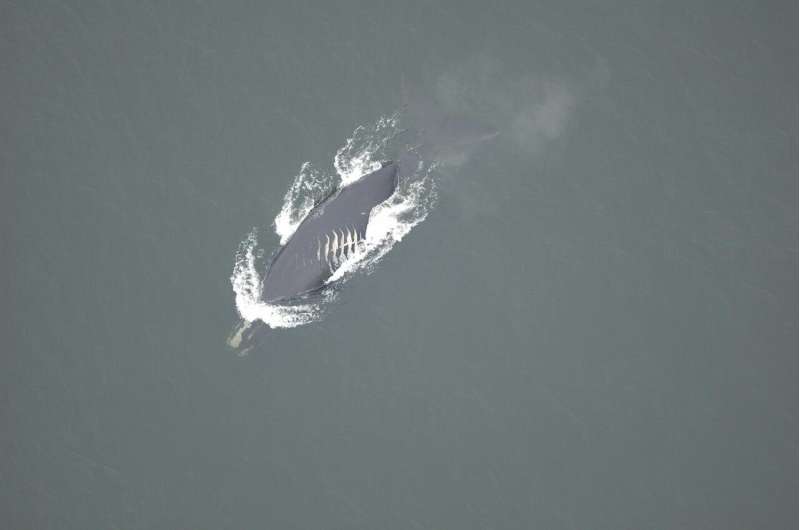
A study co-authored by scientists at the New England Aquarium has found that known deaths of critically endangered North Atlantic right whales represent a fraction of the true death toll. This comes as the death of a calf and recent sightings of entangled right whales off the southeastern United States raise alarm.
The study, published this month in Conservation Science and Practice, analyzed cryptic mortality of right whales. Cryptic mortality refers to deaths resulting from human activities that do not result in an observed carcass. The study's authors combined data on whale encounters, animal health, serious injuries, and necropsies from the North Atlantic Right Whale Consortium Identification Database curated by the New England Aquarium with the serious injury and mortality database held by the National Marine Fisheries Service. The scientists concluded that known deaths of the critically endangered species accounted for only 36% of all estimated death from 1990 to 2017.
"Our work has shown that 83% of identified right whales have been entangled one or more times in fishing gear, and an increasing number of these events result in severe injuries or complex entanglements that the whales initially survive. But we know their health becomes compromised and they eventually succumb and sink upon death," said Amy Knowlton, senior scientist with the Aquarium's Anderson Cabot Center for Ocean Life.
The study—led by Richard Pace and Rob Williams and co-authored by Knowlton, New England Aquarium Associate Scientist Heather Pettis, and Aquarium Emeritus Scientist Scott Kraus—determined that several factors interact to cause undercounting of human-caused mortalities of marine mammals. First, in order for a human-caused mortality to be determined, a whale carcass must float or strand, be detected before decomposition or scavenging occurs, be evaluated to determine cause of death, and then have that result reported. In the absence of any of these steps, information about the cause of mortality can easily be lost.
Additionally, a number of right whales have been observed entangled or injured from vessel strikes and never seen again. This suggests they died and their carcasses were not discovered.
"We have long known that the number of detected right whale carcasses does not align with the number of whales that disappear from the sightings records," Pettis said. "Since 2013 alone, we have documented 40 individual right whales seen with severe injuries resulting from vessel strikes and entanglements that disappeared following their injury. This study allowed us to quantify just how underrepresented true right whale mortalities are when we rely on observed carcasses alone."
The estimated population number for North Atlantic right whales stands at just over 350 whales. Right whales are one of the most endangered large whale species in the world, facing serious ongoing threats from vessels and fishing gear. Just in the past month, a right whale calf died in an apparent vessel strike and two right whales have been spotted entangled in fishing gear. A sport fishing boat hit and killed the calf in the calving grounds off the Florida coast on February 12. The calf was the first born to Infinity (Catalog #3230), who also suffered injuries consistent with a vessel strike. Catalog #1803, a 33-year-old male, was seen badly entangled off the coast of Georgia and Florida in mid-January, and on February 18, Cottontail (Catalog #3920) was sighted entangled and emaciated off the Florida coast. Cottontail, an 11-year-old male, was first seen entangled in southern New England last fall. In both cases, disentanglement efforts were not successful and these whales will likely die.
"These serious entanglements are preventable with regulatory changes and a commitment from the fishing industry and the U.S. and Canadian governments to do more to address this threat," said Knowlton.
For 40 years, the Aquarium's Right Whale Research Program has extensively studied this critically endangered species. Scientists focus on solutions-based work, collaborating with fishermen on new techniques to reduce deadly entanglements in fishing gear, facilitating communication across the maritime industry to reduce vessel strikes, and working with lawmakers locally, nationally, and internationally to develop science-based protections for the whales.
Explore further
Provided by New England Aquarium
Citation: Study finds human-caused North Atlantic right whale deaths are being undercounted (2021, February 25) retrieved 25 February 2021 from https://ift.tt/3knppT8
This document is subject to copyright. Apart from any fair dealing for the purpose of private study or research, no part may be reproduced without the written permission. The content is provided for information purposes only.
"right" - Google News
February 25, 2021 at 03:14PM
https://ift.tt/3knppT8
Study finds human-caused North Atlantic right whale deaths are being undercounted - Phys.org
"right" - Google News
https://ift.tt/32Okh02
Bagikan Berita Ini














0 Response to "Study finds human-caused North Atlantic right whale deaths are being undercounted - Phys.org"
Post a Comment